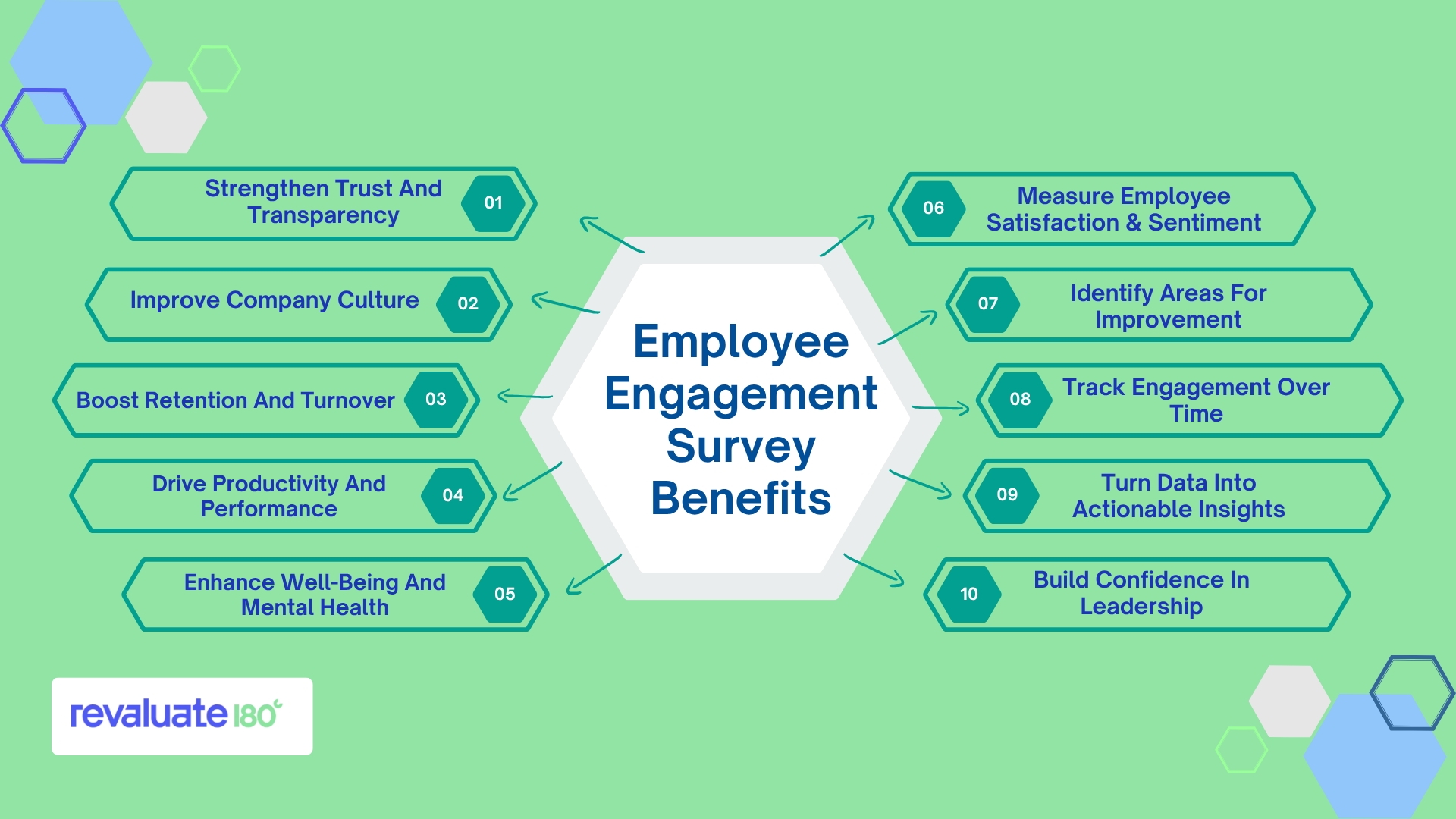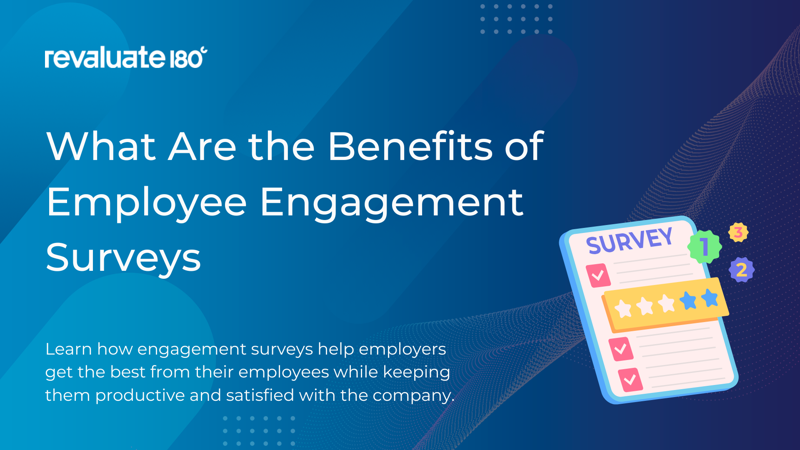A successful company or organization is similar to a well-oiled machine, where its employees constitute the machine’s core. Without a strong and well-functioning core, no machine can operate to its full capacity. Similarly, a company’s deliverables and progress are directly proportional to the satisfaction and commitment of its employees.
Employee commitment and satisfaction are measured through several employee engagement surveys. Such surveys are crucial for companies to gauge the level of happiness and contentment among their employees who work for them regularly.
In this post, we’ll learn the numerous benefits of employee engagement surveys for companies to retain their skilled workforce.
Key Summary
- Employee engagement encompasses a broad spectrum of factors that influence an employee’s commitment and satisfaction with their work.
- Most of the time, it is difficult to measure employee engagement using any standard metric or measurement.
- Engagement surveys help measure employee satisfaction and wellness at work through different question formats and survey modes.
- Learn the purpose of conducting engagement surveys and how companies can fine-tune survey questions to leverage maximum feedback on engagement.
What is an Employee Engagement Survey?
Employee engagement surveys are questionnaires that consist of a set of questions aimed at finding how happy and satisfied employees are regarding different aspects of their workplace and overall work goals. Such surveys comprise a wide range of questions on topics, such as:
- Leadership support
- Career development
- Company culture
- Job satisfaction
- Team collaboration
- Work-life balance
- Recreation
Engagement surveys can be further categorized into different types depending on their purpose, ranging from short pulse surveys and quick feedback surveys to detailed annual engagement surveys. Surveys can contain a mix of open-ended, binary (yes/no) style, eNPS-style, multiple-choice, and rating-scale-based questions.
10 Key Benefits of Conducting Employee Engagement Surveys
The purpose of employee engagement surveys is to determine how a company is functioning in support of its employees and what can be done to ensure their long-term retention. Here are some of the tangible benefits of employee engagement surveys:

1. Measure Employee Satisfaction and Sentiment
The primary objective of conducting engagement surveys is to gain insight into employees' perceptions of a company’s current policies, initiatives, leadership, culture, and other key aspects. Employees’ opinions may change depending on any new revisions or additions to the existing models. Additionally, new employees may hold different opinions on policies or initiatives compared to those of their previous companies.
For these reasons, pulse surveys and eNPS-style surveys help provide accurate scores on how employees feel about a particular area that influences employee engagement. Let’s say a group leader wants to know how a group of teams achieves work-life balance and proposes a survey. Results from the survey can indicate which team is struggling to achieve the perfect balance, allowing the company to provide additional support.
2. Identify Areas for Improvement
Engagement surveys are similar to feedback questionnaires, where employees can share their concerns that limit them from working to their fullest potential. Survey questions can allow employees to answer open-ended questions to briefly express where they feel unheard or unsatisfied.
For instance, engagement surveys conducted during an employee’s exit, or exit interviews, provide reasons why employees left the company. Companies can use these responses to identify how they can improve their existing policies and develop new initiatives to increase retention among employees.
3. Track Engagement Over Time
Survey responses and statistics are often used as benchmarks for companies to identify areas that require improvement. For instance, employees can take up surveys about the compensation and benefits that the company offers and how efficient they are.
When several employees highlighted the need for more flexible working policies post the COVID-19 pandemic, most companies started to and are still following hybrid, remote, and flexible working schedules to help their employees. Subsequent surveys revealed greater employee satisfaction when flexibility was offered as a standard benefit.
Each survey helps companies and HR professionals monitor employees’ pulse to ensure they remain productive, engaged with their team, and focused on their personal development without considering switching jobs.
4. Strengthen Trust and Transparency
Employee engagement surveys are the voice of the company’s employees, where they express their feedback and concerns regarding the company’s culture, leadership styles, team synergy, and many other aspects. Periodic engagement surveys offer employees the opportunity to raise concerns or suggest alternative solutions that can benefit them in the long run.
When companies conduct frequent pulse surveys and periodic in-depth surveys, it is a sign that the company is willing to listen to its employees and take relevant action. Surveys and revisions based on survey responses are a direct indication that a company values its employees, increasing transparency and employee trust.
5. Improve Company Culture
Surveys can be conducted within teams, groups, or for all employees in the company. Sometimes, the trends from surveys can vary among teams and groups, depending on several factors such as a team’s dynamics, leadership support, higher or lower engagement levels, and higher or lower retention rates, among others.
Survey trends can be a key focus point in establishing a consistently evolving company culture. Positive parameters from one team can be turned into insights that other teams can follow as a healthy practice, leading to a company-wide cultural shift. Similarly, employee opinions and feedback pave the way for eliminating outdated policies, making way for more relevant initiatives and trends that support the long-term retention of existing employees.
6. Boost Retention and Reduce Turnover
Failing to conduct employee engagement surveys regularly would mean that employees lose an opportunity to voice their concerns about any disturbances or dissatisfaction at work and their impact on their personal lives. For instance, if an employee is not satisfied with their annual appraisal, they must have proper channels to notify the management regarding their dissatisfaction.
The inability to resolve appraisal-related concerns often turns out to be a common reason for employees to switch companies, resulting in sudden, significant spikes in turnover. Such instances can be resolved by conducting pulse surveys after appraisals to gauge employee satisfaction levels.
Depending on the survey responses, companies can take steps to address employees through several channels, elaborating the reason for the given appraisals, or provide alternatives to adjust the inconsistencies in appraisal expectations. Such redressal actions help companies retain their talented workforce and win over their loyalty.
7. Drive Productivity and Performance
Engagement surveys enable employees to submit genuine requests for provisions and initiatives that can enhance their productivity while working. A comprehensive rewards and recognition program is a popular employee engagement initiative, followed in almost every company, that helps employees stay motivated and work better.
Each company has its own methods and portals to manage its rewards program, allowing employees to receive rewards that align with their preferences while also being recognized. Employees can use such surveys to express their preferences for reward options that benefit them the most. Then, the HR team can analyze these results to implement the majority of feasible reward options.
Thus, engagement surveys provide channels for employees to enhance their productivity, rather than seeking external opportunities that offer the desired benefits.
8. Build Confidence in Leadership
A healthy company culture is built when communication, task delegation, and feedback channels work in a bi-directional manner. While leaders are the primary sources of coordinating teams and delegating tasks based on skills, they must be equally open to feedback and scope for improvement.
Frequent pulse surveys among teams, groups, and company-wide leadership levels help employees rate leaders based on their leadership style, ability to comprehend, and resolve issues. Surveys provide leaders with the opportunity to improve themselves or develop new ways to help employees engage more effectively. These actions, in turn, help employees develop trust that their leaders are always there to support them in improving.
9. Enhance Well-Being and Mental Health
A significant impact of neutral or disengaged employees is that they slowly stop showing up at work. Surveys related to employee engagement can positively impact absenteeism because they provide employees with a channel to voice the reason for their prolonged absence.
Engagement surveys contain questions that allow employees to discuss the impact of work on their personal lives, or how the workplace can be more accommodating to ensure work-life harmony, provide employees with more time with their loved ones, and more.
Survey responses and corresponding trends help companies develop recreational initiatives that focus on the overall physical and mental wellness of employees, preventing them from resorting to absenteeism or worse, quitting.
10. Turning Data Into Actionable Insights
Today, most engagement surveys are conducted through online tools and platforms designed explicitly for surveys, or as part of larger HR software platforms. Powerful AI algorithms help such platforms provide accurate insights from the collected survey results.
While human inferences are always the final step in approving any revisions or new initiatives, insights from surveys are highly accurate in assisting leaders and HR professionals to be confident in their decisions related to engagement initiatives.
Thus, engagement surveys ease the effort of companies in understanding employee sentiments and identifying survey results and trends. The use of AI in employee engagement can facilitate more effective engagement initiatives, policy revisions, and other insights that can be directly implemented with minimal deliberation.
What Are the Best Practices for Running an Employee Engagement Survey
Here are some ideas to keep in mind while creating and floating employee engagement surveys:
Keep It Anonymous to Encourage Honest Feedback
Anonymity can be mandatory or optional in engagement surveys. Questions related to sensitive topics, such as POSH (Prevention Of Sexual Harassment), whistleblowing incidents, relationships with the immediate team and manager, must allow the employee to choose anonymity.
If not optional, HR professionals must declare beforehand that the data employees provide will not be disclosed directly to their leaders, team members, or any other concerned individuals. Ideally, survey results should not contain any personal employee details, but rather provide a consolidation of the responses received, ensuring honest participation.
Ask the Right Mix of Questions
It is essential to define the purpose of the survey and the number of questions to ask, so that employees can fill out the survey within the given time in a quality manner. Ensure the length of the survey does not contain too few or too many questions, so that employees fill it out just for the sake of completing it without providing accurate feedback.
For short and quick pulse surveys, stick to scale-based questions, such as the Likert scale, Yes/No questions, and multiple-choice questions. Use open-ended questions in long, detailed surveys. Nevertheless, short surveys can have 1 or 2 questions for employees to share their experiences in words if required.
Communicate Results Back to Employees
Employee engagement surveys are successful in providing their benefits only if the responses and corresponding team or company-level initiatives are addressed to the employees. Surveys without a clear purpose or responsive action from the company can make employees feel that such surveys are merely for show.
Most surveys are conducted over a specified duration, after which the relevant HR department compiles the results with the assistance of summarizers and similar AI tools. The insights are then shared with the relevant leaders and senior management, after which the leaders discuss the results with their employees. Furthermore, they try to gather more insights from employees to help refine existing initiatives or develop new policies or benefits.
Act on Insights to Build Trust
Employees gain trust and confidence in their company leaders when they decide to develop better initiatives and policies in response to engagement survey results. Leaders must carefully interpret the survey results and make decisions that are favourable to all employees.
Leaders must not merely follow majority opinions when making decisions, but also consider other factors such as long-term feasibility, financial constraints, implementation challenges, and the impact on overall employee productivity. The inability to meet employee expectations must be communicated through the right channels with sufficient data, so that employees understand the situation and offer their cooperation.
Final Thoughts - Why Conduct an Employee Engagement Survey?
Engagement survey results contain valuable data that help companies make informed decisions regarding employee well-being and long-term retention. Thus, it is essential to conduct periodic employee engagement surveys that include questions on various topics affecting their day-to-day work life.
Deriving inferences from survey results and taking subsequent corrective actions are critical tasks that even the best corporate leaders can struggle with. That is why many companies seek the aid of experienced HR consultants and platforms to help make better management decisions. Such services help make accurate decisions from the data gathered, while also analyzing past data metrics to prevent previous mistakes in retention and engagement.
Revaluate180 has emerged as one of the most sought-after HR consulting services, helping businesses of all sizes make more thoughtful decisions through data-driven insights. Our employee engagement and development initiatives are designed to create a seamless experience across the entire employee lifecycle, from hiring the right candidates to maximizing retention and ensuring thoughtful, supportive severance when needed.

Unlock AI-Powered Hiring Analytics
Transform the way you hire with insights that create aligned, collaborative, and high-performing teams.
 Smarter Hiring Decisions
Smarter Hiring Decisions
 Reduce Expensive Turnover
Reduce Expensive Turnover
 AI-Driven Insights
AI-Driven Insights
 Optimize Team Performance
Optimize Team Performance

FAQs
1. What is the main purpose of an employee engagement survey?
Employee engagement surveys aim to understand how committed employees are to their work goals, as well as to their team members, peers, and leaders within their company. Engagement surveys also gather data to measure how satisfied employees feel with the company’s existing policies and initiatives and encourage them to report any concerns as feedback.
2. Why are employee engagement surveys important?
Periodic employee engagement surveys help companies in the following areas:
- Improve retention and reduce turnover.
- Promote overall employee well-being.
- Help leaders understand employees better.
- Continuously improve the company culture.
- Stand out among competitors by developing innovative and employee-friendly initiatives.
- Garner trust and confidence from employees.
3. How often should companies conduct employee engagement surveys?
Short or brief engagement surveys can be conducted on a weekly, monthly, quarterly, or yearly basis, or at any other frequency, depending on the criticality of analyzing engagement levels within the company. Detailed surveys can be conducted once or twice a year for better insights. It is important to space surveys with sufficient intervals so that you do not burden your employees with surveys.
4. How can Revaluate180 help with employee engagement?
Revaluate180 offers a wide range of flexible and tailor-made programs that can help your teams improve their coordination and workplace dynamics. Through our programs and workshops, employees learn to harness collective strengths, identify obstacles to smooth teamwork, and collaborate to achieve common goals.
